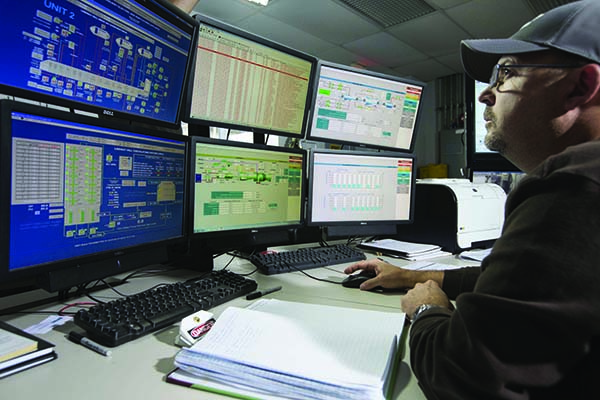To remain efficient and profitable, utilities must anticipate the ebb and flow of the market. That means companies must gain visibility into the generation and consumption of energy. With network-level optimization, utilities can acquire a holistic view of the energy landscape in real-time.
Energy consumption patterns used to be very predictable. There was a spike in the morning as people woke up, another spike in the late afternoon as people returned home from work, and limited consumption through the night. However, the pattern of consumption and generation has grown increasingly complex over time. People aren't consuming energy during working hours the way they used to; in fact, they are consuming far less. But energy from solar is ample during those hours, which changes the demands on central generation. Electric vehicles are also changing consumption patterns as people charge cars at work, home, or both. Those are just two simple examples of how demand has changed, but there are dozens more.
 |
|
1. Changing with the times. Network-level optimization can help utilities better understand the power landscape in real time. Courtesy: GE Power |
The reality is that utilities, grid operators, and energy providers all crave more information as they watch and prepare for the changing landscape of supply and demand (Figure 1). The only way for utilities to anticipate the ebb and flow of the market to remain profitable and efficient is to gain visibility into the generation and consumption of energy. With unpredictable weather patterns and new pressures on the grid from smart cities and electric vehicles, among other challenges, there's never been a more important time to rethink the energy network.
Right now, the entire power industry is leveraging, on average, less than 5% of all industrial data. It's not that the data is unusable, but it requires very specific expertise to consume and gain insights. This mass of untouched data means that utilities are only seeing a tiny sliver of the energy picture. Without an accurate view of the network, how can they possibly be making the most informed decisions? They can't. That's where network-level optimization comes in.
What Is Network-Level Optimization?
Network-level optimization is the most critical aspect of the world's shared energy future. It gives utilities a holistic view of the energy landscape at any given moment, in real time.
Network-level optimization provides unprecedented capabilities to enhance optimization models, understand the overall performance of the network, and gain visibility into the generation and consumption of energy. This approach, fueled by data and paired with advanced analytics, represents a fundamental shift for the energy industry.
Companies can now unlock unique insights from various parts of the energy journey, from generation to consumption. It also enables them to orchestrate electricity in ways previously unimagined–not only for current applications, but also for future, unforeseen scenarios.
The power of data helps guide utilities from a reactive to proactive approach in crucial scenarios. Advanced analytics software in a single platform helps companies get the most out of their assets, predict and prevent failures, and uncover opportunities for greater performance and efficiencies. Giving companies the full picture of their assets and the energy grid empowers them to capture insights in the entire network, driving outcomes of a magnitude unattainable until today.
But the problem is network-level optimization is not a widespread practice in the power industry. Utilities today are only beginning to recognize the real-world impact it can make. It's both frustrating–because companies can start acting and making better use of data now, but many aren't–and incredibly exciting as there is so much impact to be made.
Take energy trading as an example. There's no other traded commodity that has the volatility energy does. For example, over the course of a day, a megawatt-hour of energy may trade as low as $0 (or even negative), or it might go as high as $3,000, and that's within a single day.
The current volatility of energy trading is unacceptable and would never be tolerated in any other industry. At the moment, energy is being wasted and no one should benefit from that. If utilities can harness these massive shifts, consumers can be the beneficiaries of consistent and maximized efficiency at sustainable costs.
So, how does network-level optimization come into play here? With this complete view, utilities can extrapolate when the price of energy on the open market is so low that it makes far more sense to buy power than to produce it. Alternatively, utilities can determine when demand is strong, and decide that it may be wise to over-produce and sell the excess. This may even be when that means slightly degrading the useful life of an asset (Figure 2).
These decisions can be made in an instant and are unlocked by understanding the relationship of each piece of the network and market. As utilities gain control of the energy production proactively, the price of the commodity will both stabilize and decrease. The key element in energy trading, however, is still the human factor. Overall, the ability to successfully execute the trading floor's tactics requires better data, mutual understanding, continuous dialogue, and a comprehensive strategy in which all parts of the organization are aligned.
Real-Time Market Platform
Here's an example of how that's being done today. With the responsibility of ensuring the reliability of regional grids, regional transmission organizations (RTOs) are key stakeholders in developing next-generation market systems for low-risk, high-value energy trading in evolving electricity markets worldwide. RTOs don't own any generation or transmission assets like utilities do, but they are foremost responsible for ensuring a transparent, fair, and efficient electricity market to maintain power grid reliability.
One RTO in North America, operating one of the world's largest real-time energy markets, has been developing tools for processing, clearing, and settling transactions in the energy market. The system, e-terramarket, combines financial and physical considerations with built-in pricing capabilities. The real-time solution runs and clears the market every five minutes. Based on bid information that market participants submit, as well as confirming commitment of those resources, the RTO is able to determine the levels of generation needed to ensure a healthy and wholesale market in both real-time and day-ahead scenarios.
Further, the platform solution actually helps facilitate the running of the wholesale market. From the point that market participants interact with the RTO–submitting the bid through their respective interfaces to the RTO collecting bids and running the market–the optimization engine is constantly active. Even against complicated system constraints, including those on the transmission and operating sides, it takes all bids into account to maximize social welfare.
The solution, built using proven and emerging internet, intranet, and relational database technologies, provides the real-time information needed to assess the impacts of distributed energy resources (DERs) in the grid reliability and power balance, turning the threat of DERs into opportunities. The e-terramarket system is just one piece of the puzzle. Network-level optimization and the full picture it provides will be essential for all energy practices in the future.
Maximizing Resources
When utilities are able to maximize the use of their technology, their costs decrease, ultimately lowering costs for consumers. This means more reliable access to electricity for more people. Network-level optimization is the missing link to the unrealized potential of utilities across the globe. Those who are closest to the hardware are in the best position to optimize it as they have knowledge of the asset and ability to identify which datasets are most integral for optimization.
The convergence of industrial with digital is the most significant movement of our time and is revolutionizing the way we power our lives. The new era of "Digital Energy" is here, and network-level optimization will be the key to making electricity more affordable, reliable, accessible, and sustainable for everyone. ■
–Steve Martin is Chief Digital Officer with GE Power.

